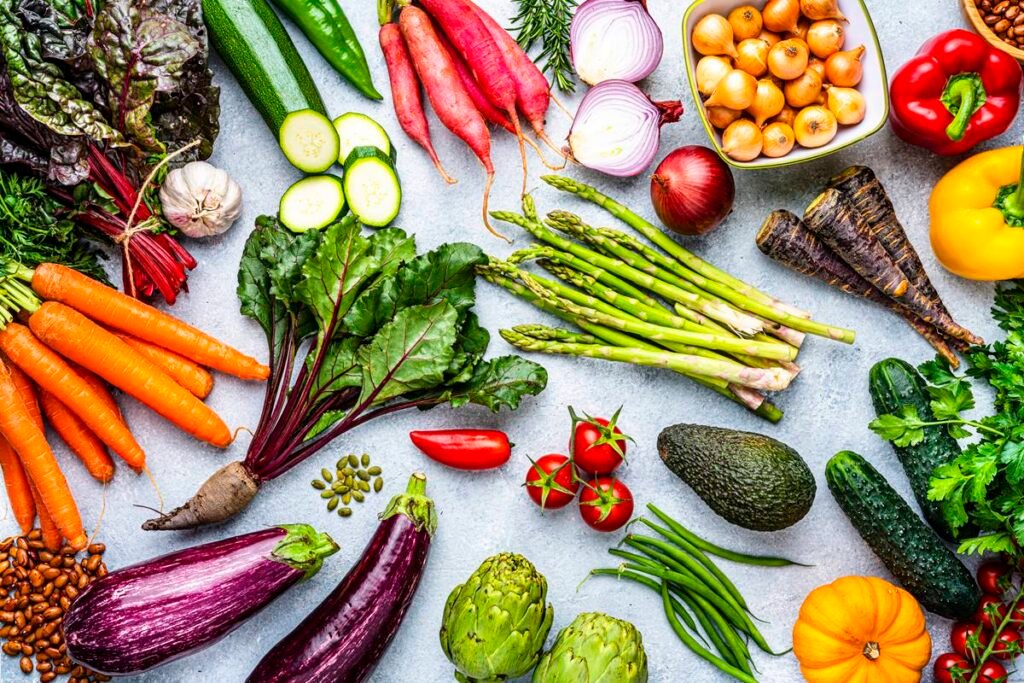You’ve probably heard the saying: “You are what you eat.” Well, when it comes to blood circulation and blood sugar levels, that phrase couldn’t be more accurate. A diet rich in vegetables not only helps maintain a healthy weight, but also strengthens the heart, clears the arteries, improves overall circulation and helps keep glucose levels in check.
But how exactly do vegetables support circulation and blood sugar control? Let’s find out!

1. Rich in Antioxidants: Protection for Blood Vessels and Cells
Vegetables are packed with antioxidants like vitamin C, beta-carotene, and flavonoids. These compounds fight free radicals—unstable molecules that damage cells, including the walls of blood vessels.
When your blood vessels are healthy and less inflamed, blood flows more freely, reducing the risk of high blood pressure, stroke, and heart attack.
And there’s more: antioxidants also help protect insulin-producing cells in the pancreas, supporting better glucose regulation.
2. Natural Source of Nitrates: Better Blood Flow, Lower Pressure
Certain vegetables like beets, spinach, and arugula contain natural nitrates. When metabolized, these nitrates turn into nitric oxide—a compound that relaxes and widens blood vessels.
This helps to:
- Lower blood pressure
- Boost physical performance
- Improve oxygen delivery to muscles and the brain
Bonus: improved circulation means better glucose uptake by muscles, which helps maintain stable blood sugar levels.
3. Fiber That Cleans from the Inside Out
Veggies like broccoli, carrots, kale, and zucchini are rich in both soluble and insoluble fiber, which help to:
- Lower “bad” LDL cholesterol
- Prevent fatty plaque buildup in the arteries
- Regulate bowel movements—essential for overall circulatory health
And for blood sugar? Soluble fiber slows down the absorption of sugar, preventing spikes in glucose levels after meals.
It’s like giving your body an internal cleanse—naturally and effectively.
4. Natural Anti-inflammatories
Many vegetables contain bioactive compounds with anti-inflammatory effects. Kale, for instance, is rich in sulforaphane, a substance that helps reduce chronic inflammation—common in people with poor circulation, varicose veins, or fluid retention.
Less inflammation = less risk of blood vessel blockage.
And chronic inflammation is a key player in insulin resistance, so reducing it helps improve insulin sensitivity too.
5. Hydration and Lightness
Vegetables like cucumber, lettuce, chayote, and Swiss chard have a high water content, which helps keep the body hydrated. Hydration is essential to keep the blood flowing smoothly through the vessels.
Plus, since these foods are low in calories and easy to digest, they don’t overload the digestive system—allowing the body to focus on optimal blood flow and better metabolic balance, including blood sugar stability.
Practical Tips: How to Eat More Veggies Every Day
- Start lunch and dinner with a colorful salad
- Use veggies as the base for soups, stews, and stir-fries
- Add leafy greens and sliced vegetables to sandwiches and wraps
- Make functional juices with kale, beet, cucumber, and lemon
- Switch up how you prepare them: steam, roast, grill, eat raw or sauté
Conclusion
Adding more vegetables to your daily diet is one of the simplest—yet most powerful—steps you can take to care for your circulatory system and stabilize your blood sugar naturally. They cleanse, nourish, hydrate, and protect your body from the inside out. And the best part? They do it deliciously!
So why not start today by making your plate more colorful?
Your heart, your blood vessels, and your glucose levels will thank you! 💚